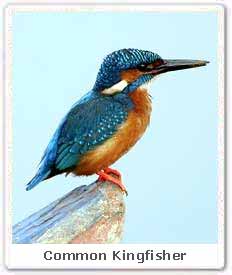| Kingdom : | Animalia |
| Phylum : | Chordata |
| Class: | Aves |
| Order : | Coraciiformes |
| Family : | Alcedinidae |
| Genus : | Alcedo |
| Species : | A. atthis |
| Zoological name : | Alcedo atthis |
| Found In | Corbett National Park, Bandhavgarh National Park and Sunderbans National Park in India. |
 Physical appearance : Common Kingfisher is 17 cm in
length and weigh around 30- 34 g. Their wingspan is 30 inches long. Their
underparts are bright orange in colour with the white bib. Their wings are
bluish green and the tail is bright blue in colour. They have blue head with
the white mark on either side of it. They have short legs which are colored
in orange. The wings and tails are short while the bill is long and pointed.
Physical appearance : Common Kingfisher is 17 cm in
length and weigh around 30- 34 g. Their wingspan is 30 inches long. Their
underparts are bright orange in colour with the white bib. Their wings are
bluish green and the tail is bright blue in colour. They have blue head with
the white mark on either side of it. They have short legs which are colored
in orange. The wings and tails are short while the bill is long and pointed. Presence in India : Common Kingfisher is mostly found in the state of Haryana in India Common Kingfisher can also be spotted in the Corbett National Park, Bandhavgarh National Park and Sundarbans National Park in India.
Habitat : Common Kingfisher prefers to live near streams, slow flowing rivers, ponds and lakes.
Diet : Common kingfisher feeds on aquatic insects, small fish and prawns. They mostly hunt during the morning or evening hours.
Reproduction : Common Kingfisher usually mate during the spring season. Males try to attract the females with the fish in their beaks. The females lay 6 – 7 eggs. Eggs are incubated for about 20 days. Fledging period rests from 23 -27 days. They do-not build nests, they place their eggs on a litter of fish bones and disgorged pellets. Both the males and females bring food for the young ones and take care of them. Young ones are somewhat blue to pale red in colour. Most of the Kingfishers are territorial.
Conservation status : Least concern. They are present in large numbers. They are usually found near the streams, lakes and pounds. Their population has seriously declined due to the cold weather.
Lifespan : The lifespan is of 7 years.






